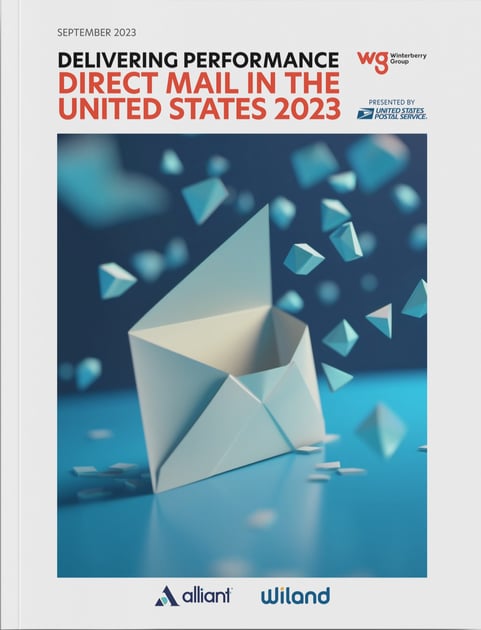NEW RESEARCH ON U.S. DIRECT MAIL UNDERSCORES ADDRESSABILITY, MEASURABILITY AND PERSONALIZATION ATTRIBUTES
September 20, 2023 •Winterberry Group

Brands steadily investing in more data-driven direct mail applications to attract customers, seeking out performance-oriented benefits that support broader omnichannel strategies, according to new report from leading consulting firm.
NEW YORK – While other traditional media channels are declining—and marketers wrestle with higher costs and challenges associated with the addressability of certain digital media—U.S. brands are continuing to invest steadily in direct mail marketing to acquire and grow customers, reports Winterberry Group in its newest white paper “Delivering Performance | Direct Mail in the United States 2023.” Direct mail expenditures in the United States are expected to exceed $39.3 billion this year, according to the research—still lagging pre-COVID spending of nearly $43.2 billion (in 2019), but up from nearly $38.8 billion in 2020.
“The resiliency of direct mail in the United States is rooted largely in its unique capability as a performance marketing channel,” said Jonathan Margulies, managing partner, Winterberry Group, one of the paper’s co-authors. “While marketing practitioners have long been migrating spend to performance-oriented digital media channels, a growing number are coming to see direct mail as a powerful tool for delivering curated, personalized messages and content on the basis of data triggers—helping support customer acquisition, incremental sales and other key marketing objectives. It’s this unique capability that is likely to keep DM at the forefront of the marketing mix well into the future.”
Delivering Performance is the result of an extensive primary research effort initiated by the United States Postal Service, and conducted by Winterberry Group—involving the interview contributions of dozens of thought leaders in the agency, data, printing, mailing service and technology communities, as well as survey responses from more than 500 enterprise and middle-market brands and agency executives. The research effort spanned November 2022 to August 2023.
“In a marketing world where digital channels tend to be the default, we are seeing savvy marketers add direct mail to their omnichannel campaigns because its tactile nature makes it more memorable and generates much higher response rates than digital channels,” said Tom Foti, vice president of product solutions at the United States Postal Service.
According to the white paper, direct mail continues to play a prominent role in a U.S. marketing mix otherwise increasingly dominated by digital channels due to six overarching trends:
- Brands have come to widely embrace the “omnichannel” philosophy, emphasizing the integration of all marketing channels, both digital and traditional, in a diverse media mix
- Marketers are increasingly prioritizing performance—the ability to achieve specific, incremental objectives with respect to customer acquisition, sales and other outcomes—over other use cases
- Growing costs and challenges associated with the addressability of data-driven digital media are leading many marketers (and digitally native direct-to-consumer brands, in particular) to test alternative channels, like direct mail, in support of their growth ambitions
- Improvements in the integration of data and creative content, coupled with the advent of less expensive and more capable marketing technologies, are allowing direct mailers to achieve long-promised value from on-demand production, personalization, trigger-driven programs, retargeting and other innovations that capitalize on intent signals in the buying cycle
- The continued robust availability of licensable third-party data—backed by a mature, multifaceted supply chain—represents the foundation upon which brands responsibly orchestrate their direct mail programs at scale; and
- Seeking to manage the vast complexity inherent in modern marketing, brands are looking to media channels and supply chain partners that provide for flexibility, scalability and the ability to rapidly adapt to changing needs.
Additionally, the research found:
- 45% of marketers say the most important use case direct mail fulfills is customer acquisition
- 59% of marketers are taking steps to better integrate their use of direct mail with other channels
- 53% of marketers are shifting to more personalized content over the next year
Delivering Performance is published in partnership with the United States Postal Service, with the support of Alliant and Wiland as well as supporting sponsors Freedom, LS Direct, NaviStone and Path2Response.
“With changing consumer behaviors, economic challenges and major shifts in other channel capabilities, direct mail’s role has been questioned more than ever,” said Donna Hamilton, chief innovation officer at Alliant. “We are thrilled to participate in this important research, which emphasizes what Alliant sees in our day-to-day partnerships; that direct mail is still a vital tool for acquisition and engagement across the buying journey. New and creative omnichannel approaches are breathing new life into direct mail and we expect the channel to continue its evolution and find a more stable place in the modern marketer’s channel mix.”
“Wiland is pleased to have sponsored this timely report by our colleagues at Winterberry Group,” added Drew May, chief client officer at Wiland. “Its thorough research and deep analysis highlight the ongoing importance of direct mail in the modern marketer’s toolkit. The report will greatly benefit veteran direct mailers as well as digitally native brands that are new to the channel.”
The full study, including an executive summary, is available for download from Winterberry Group, via a free registration. Winterberry Group’s research team will join its partners from the USPS to present and discuss the research findings during a webinar scheduled for October 20, 2023 at 12:00pm EDT. Attendance is free and now available for registration.
ABOUT WINTERBERRY GROUP Winterberry Group is a specialized management consultancy that offers more than two decades of experience and deep expertise in the intersecting disciplines of advertising, marketing, data, technology and commerce. Headquartered in New York, WG helps agencies, marketing service providers, technology developers and information companies—plus the financial investors, brands and publishers who support these organizations—understand emerging opportunities, create actionable strategies and grow their impact and value. For more information, please visit www.winterberrygroup.com and follow us on X (formerly Twitter) @WinterberryGrp
XX
Media Contact:
Brittany Meeks
Engagement Director
Winterberry Group

